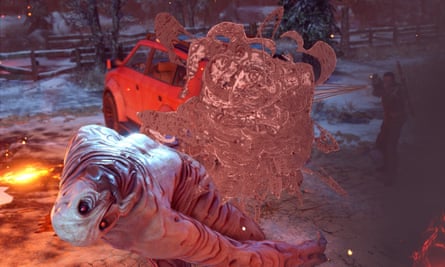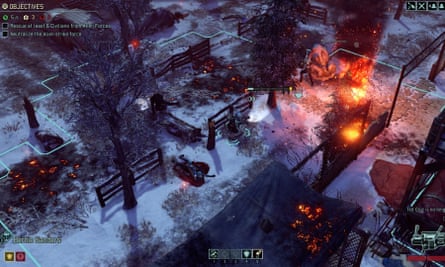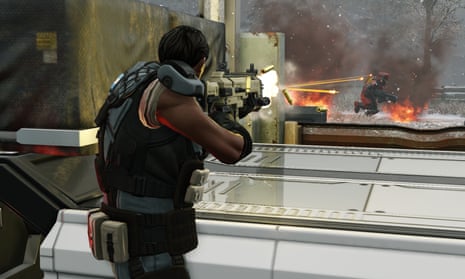Among XCOM’s distinctions is that it is a difficult game, so the sequel’s concept is quite brilliant: the first time around, you lost. Firaxis’ 2012 strategy title was a remake of a 1994 original, UFO: Enemy Unknown, which cast you as the commander charged with responding to an alien invasion of Earth – building up the eponymous organisation, responding to attacks across the globe, and hunting down alien operating bases. Chances are if you played it, you also failed to save humanity. And this is where XCOM 2 kicks off.
Twenty years have passed since the original game’s events, with Earth now ruled by an alien-human dictatorship known as Advent. It’s a clean and organised dystopia, with people efficiently marched through weapons scanners and dispatched for any infractions real or perceived by Advent’s troopers. This staple enemy type, though humanoid in appearance, is an unholy genetic hybrid – and just the tip of the iceberg you’ll eventually uncover.
The tutorial establishes this new XCOM as a ragtag rebel group, abandoned by most of its old allies (who have signed up with the alien rulers) and lacking leadership. Welcome back, commander. At once the scenario fits beautifully with how XCOM 2’s mix of turn-based strategy and base-building works – in the original game you apparently had every nation on Earth’s backing, but could still run out of doctors or scientists or troopers. Here the restrictions are as tight as they were but, when you’re scrabbling every day just to find supplies and keep out of sight, the whole setup makes much more sense.
XCOM 2 splits between missions on the ground, where you control a group of soldiers (initially four, soon six) and fight aliens/save civilians/steal technology, and the XCOM base itself. The latter is an incredibly lavish production of what is basically a side-on 2D view of an ant mound, which zooms in and out of the rooms as you click through them. There’s a shimmering effect when you enter the map room, where a 3D globe moves towards the screen and breaks apart into constituent particles as it does so, a sight so beautiful you just want to stick it on repeat with a Pink Floyd album.

Managing the base is a matter of choosing priorities – there are a number of specific rooms covering science research, weapon production, and so on, but each can only work on a single project and you’ll always have a big list. It makes every decision an important one, and comes to define your tactics in a wider sense. If you just race up the weapon and armour tech trees as fast as possible, you’ll be ignoring soft buffs to the base’s efficiency and capabilities which may have a bigger payoff in the long term.
This side of XCOM 2 is straightforward, a case of making strategic choices rather than actually running a base, but the scarcity of resources and the impact of your decisions give it huge influence over the campaign. Supplies and personnel really are precious, and making bad calls – like setting your scientist to work for 14 days on magnetic weapons, when you have other projects that will come to fruition much quicker – can you leave your operation feeling lopsided for weeks. Many games that incorporate a meta-structure of base building silently have a safety net, meaning that the base gets better over time regardless of your involvement and it’s hard to screw it up. Not here. Mismanage your base in XCOM 2 and it will go under by degrees and collapse.
Nowhere is this more obvious than in your soldiers. XCOM’s troops are each a randomly generated personality with their own name and looks, and they are a valuable commodity indeed. Their name and appearance can be edited, an important touch, because over multiple missions your troops will level up into various classes (sniper, scout, etc) and become much more efficient operators – mentally stronger, more health, better shots and various abilities. The missions have an authentic edge of risk here, because of course you get attached to these toy soldiers, but if someone dies they’re dead – and all that investment of time and resource goes with them.
On my first campaign run, in this time for heroes, I decided to try and take back the Earth with current US presidential candidates. Surely Trump and Sanders would set aside petty squabbles for the good of humanity? The highlight of this short-lived team was the death of Hillary Clinton and severe wounding of Donald Trump during a mission, simply because for some reason Ted Cruz stopped panicking and turned into Rambo. Faced with near-certain defeat Cruz proceeded to absolutely shred through the alien forces with multiple crits and returned to base as the soldier who dealt most damage, made more attacks (the end-of-mission stats are lovely) and brought home the loot. A good day for fruitcakes.

The team was short-lived, however, because in the very next mission I over-extended our conservative hero. When Cruz was wounded, Bernie Sanders was mind-controlled by an alien Sectoid and shot him in the back. Trump was in the hospital, but replacement Marco Rubio panicked and ran into cover. The mind-controlled Sanders was promptly slaughtered by the aliens on the next turn, which saw Ben Carson also panic. I never regained control: Rubio and Carson, white-eyed and trembling, hid in their own little corners as the aliens advanced, and never came home.
This thread of consequence runs through every part of XCOM 2, and is why it’s such a rewarding strategy game. The missions are viewed from an isometric perspective and take place over turns – you move all your troops, then the aliens move. The basic principles are that fog-of-war exists – so you can’t “see” enemies unless one of your troopers can see them, and vice-versa – and combat comes down to taking/flanking cover. Positioning and information is everything.
XCOM 2 is a serious strategy game, even on normal difficulty. The AI rarely makes stupid moves, and will respond to your mistakes with absolutely brutal efficiency. My most common mistake in the first few hours was advancing too far forward with one trooper, spotting a group of enemies, and watching the pioneer get slaughtered with their companions too far away to help. This is a crucial part of how XCOM 2 works – allow your troops to get isolated from each other, or leave a flank exposed, and you’ll be punished.
This doesn’t mean that one mistake loses you the mission, but that one baddie flanking your team can be the start of a huge downwards spiral. It might get a nice shot in and kill one of your soldiers instantly (flanking attacks have a higher hit and critical percentage), it may stun them, it may just get in a meaty blow, or it may set up for the next turn. Your whole team has to pivot to engage this immediate threat, and then the AI will take full advantage to pressure from other angles.
This kind of ruthlessness is incredibly valuable in a strategy game, because when you have a weakened soldier it’s instinctively understood that the AI will take it out if given half a chance. It makes your tactics much more responsive and forces major decisions that you often don’t want to make – and beyond even this, XCOM 2’s missions have a forward momentum that the original’s often lacked.
At the core of XCOM’s strategy is “overwatch”, which is when you use a soldier’s turn to place them in an alert mode – if an enemy crosses their line of sight, the soldier will open fire. In a game all about moving from cover to cover the utility is obvious, but it also means you can rely on it too much and end up in standoffs (the aliens can also use overwatch.) XCOM 2 makes this impossible by giving most of the missions a strict turn limit – you’ll have to grab a VIP and make it to an extraction zone in 12 turns, for example, or disarm a bomb or stop a data transfer.

The original had missions with turn limits, but here they’re much more common and it’s a fiendish change to the way things work (as well as in-keeping with the guerrilla theme.) XCOM 2’s difficulty and extreme consequences tempt you towards defensive strategy, the turtle mindset, but mission limits demand some sort of forward-momentum. It’s constantly pushing the player out of their comfort zone, encouraging daring play, and marks a distinctive switch from how the original’s missions played out – and one that’s all for the better.
XCOM 2 is defined by smart design choices like this, taking what was already a great formula and streamlining or adding to it in a way that makes sense. Many missions now begin with your group concealed, meaning you can move up and surround enemy forces before making a move – letting you start missions with a bang, or in some cases even avoid early encounters altogether. A doomsday clock is soon introduced, giving the base-building the same kind of urgency that the turn-limited missions have. The resources are even tighter, and there’s even more to do. This all adds up to an intensity very few strategy games have ever reached.
The only major failing here is a technical one, which is the game’s inability to handle multi-level buildings. This is important, because these structures are found in almost every mission and the experience of navigating them is always terrible. It is not easy, of course, to create a 3D building viewed from a top-down isometric angle, which shows different floors by making others transparent. But XCOM 2’s cursor-jumping solution is just a frustration, to the extent this would probably be a better game if it had no multi-levelled buildings at all. In such a polished and beautifully designed package, it’s irritating that one of the few flaws is so central and persistent.
XCOM 2 is a perfect example of how iteration should work for games: it takes a great original, fixes and streamlines the problems, and doubles-down in unexpected areas. Among its greatest achievements is adding a sense of pace to the overall campaign and the moment-to-moment combat. This is an about-turn from the principles of the original that could have gone wrong but instead is the making of the experience. It’s easy to be blasé about big studios such as Firaxis working with brands such as XCOM, because this was always going to be a good game and a big seller. But XCOM 2 over-delivers in almost every area, and more than that has faith in its players – it pressures and harries and asks more from you than ever before. In a game built around consequence this means defeat is a familiar taste, but when victory arrives it has never tasted sweeter.
2K; PC

Comments (…)
Sign in or create your Guardian account to join the discussion